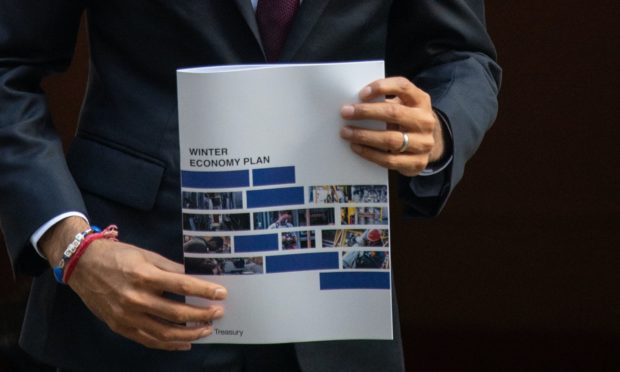Key among the new announcements unveiled by Rishi Sunak in his winter crisis plan is the creation of the new job support scheme as a successor to furlough.
The Chancellor said it was time to create “new opportunities” in order to move the economy forward over the next six months, which means supporting people to be in “viable jobs which provide genuine security”.
The new job support scheme is designed to prevent employees from being made redundant because companies have less demand for their goods but will support those who can work, albeit on shorter hours.
What is the scheme?
- The job support scheme will see the government directly support the wages of workers who can work for at least a third of their normal hours.
- The employer will continue to pay employees for the hours they work but for the remaining hours not worked, the government and the employer will each pay a third.
- The government will pay a third of hours not worked up to a cap of £697.92 a month. This will mean employees earn a minimum of 77% of their normal wages.
- This means businesses will be required to pay more than half (55%) of their employees’ salary, as a minimum, for a third of hours worked.
- The scheme will open on November 1 and run for six months, until 2021.
Who is eligible?
Employers:
- All employers with a UK bank account and UK Paye schemes can claim the grant.
- It is open to all employers across the UK, even if they have not previously used the furlough scheme.
- All small and medium-sized firms will be eligible but larger firms will only be able to access the scheme if their turnover is lower now than than before experiencing difficulties from Covid-19.
- The government has also said it expects that large employers will not be making large capital distributions (such as dividends), while using the scheme.
Employees:
- Employees must be on an employer’s Paye payroll on or before September 23.
- For the first three months of the scheme, the employee must work at least a third (33%) of their usual hours.
- After three months, the government will consider whether to increase this minimum hours threshold.
- The Treasury has confirmed employees will be able to cycle on and off the scheme and do not have to be working the same pattern each week, but each short-time working arrangement must cover a minimum period of seven days.
What does the grant cover?
- For every hour not worked by the employee, both the government and employer will pay a third each of the usual hourly wage for that employee. As mentioned above, this will be capped at £697.92 a month.
- Grant payments will be made in arrears, reimbursing the employer for the government’s contribution.
- Employees cannot be made redundant or put on notice of redundancy during the period within which their employer is claiming the grant for that employee.
Practical example:
Sarah normally works five days a week and earns £350 per week.
However, the company she works for is suffering reduced sales due to coronavirus.
Rather than making her redundant, the company could put her on the job support scheme.
If Sarah worked for two days a week (40%) of her usual hours then her employer would pay her £140 for the days she works.
For the days she is not working (three days or 60%, worth £210), she will earn two thirds, or £140, bringing her total earnings to £280, 80% of her normal wage.
The government will give a grant worth £70 (one third of hours not worked, equivalent to 20% of her normal wages) to Sarah’s employer so she can retain her job.
How can firms apply?
Employers will be able to make a claim online through gov.uk from December 2020. They will be paid the grant on a monthly basis.
Grants will be payable in arrears, meaning a claim can only be submitted in respect of a given pay period, after payment to the employee has been made and that payment has been reported to HMRC via an RTI return.
What has been the reaction from the business community?
Aberdeen and Grampian Chamber of Commerce said the new scheme gives firms a “small amount of scope” to try their best to retain workers in the months ahead but believes “more needs to be done” to protect the worst-hit parts of the economy, including the aviation sector, hospitality, live events and the supply chain.
Russell Borthwick, chief executive of the organisation, said the need for an evolution of the furlough scheme has been “well-recognised” and was a “persistent theme” in discussion with members.
“However, we repeat the message we are hearing from SMEs across the north-east and beyond. It is not tenable for governments to instruct businesses in key industries like aviation, hospitality, live events and their supply chains to limit or effectively close their operations, and yet find a way to survive with a scheme offering such a limited contribution to employment costs for staff that cannot be productively engaged for their full working week.”
Alison Henderson, CEO of Dundee and Angus Chamber of Commerce, described the announcement as “broadly welcomed” but said “more information and a longer-term cohesive plan” is needed.
She said: “We’re never going to get as much as each sector needs but what we saw certainly is going to dramatically help hospitality and tourism businesses who were told this week they would be closing at 10pm.
“Many businesses were really worried about what they were going to do once furlough came to an end.”
However, the measures will only “go so far” and emphasis must be given to growing businesses and retraining in the months ahead, Ms Henderson added.
CBI Scotland claimed the “bold steps” outlined by the Treasury will “save hundreds of thousands of viable jobs” this winter.
Tracy Black, CBI Scotland director, said: “It is right to target help on jobs with a future, but can only be part-time while demand remains flat.
“This is how skills and jobs can be preserved to enable a fast recovery.
“Wage support, tax deferrals and help for the self-employed will reduce the scarring effect of unnecessary job losses as the UK tackles the virus. Further business rates relief should remain on the table.”
Andrew McRae, the Federation of Small Businesses’ (FSB) Scotland policy chair, believes the measures go “some way to filling the most obvious support gaps” but stressed ministers must be “prepared to go further”.
He added: “We’re missing new support for the one in 20 Scottish businesses that are still unable to trade at all because of government rules, such as soft play centres and nightclubs.
“And the chancellor must ensure that the strings attached to the new job support scheme don’t make it inaccessible to firms without large HR and tax departments or exclude seasonal operators.”





